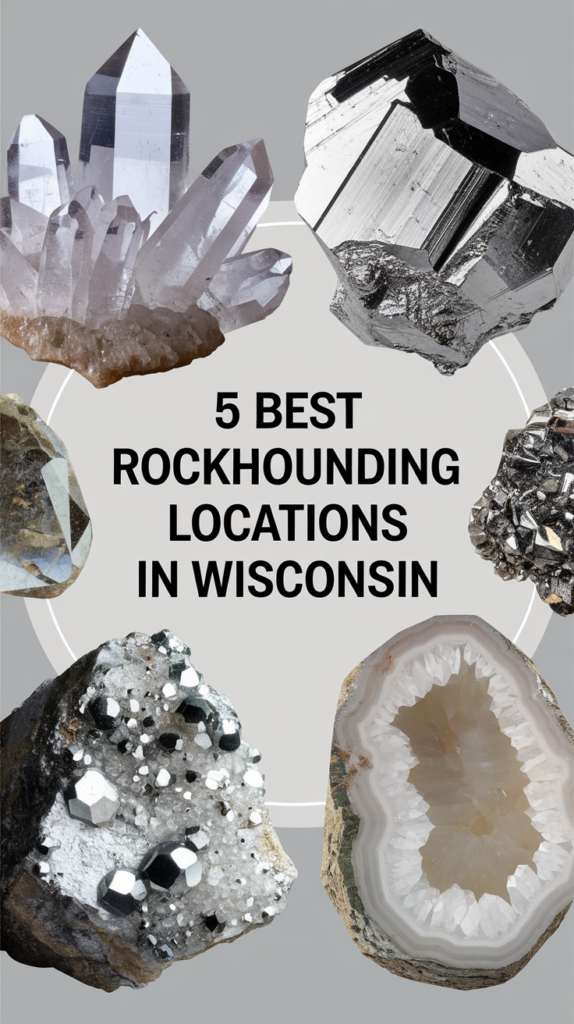
Wisconsin’s rich geological history spans billions of years, creating a paradise for rockhounds and mineral enthusiasts. From the ancient bedrock of the north to the fossil-rich limestone of the south, the Badger State offers an incredible variety of specimens for both novice collectors and experienced mineralogists. As someone who’s spent countless weekends exploring Wisconsin’s diverse geological formations, I can attest that few states offer such a rewarding rockhounding experience. In this comprehensive guide, we’ll explore the five best locations for rockhounding in Wisconsin, along with essential tips to make your rock-hunting adventures both successful and memorable.
Lake Superior Shore: Agate Hunter’s Paradise
The shoreline of Lake Superior stands as Wisconsin’s premier destination for agate hunting. I’ll never forget my first visit to this area – the morning sun glinting off the wet stones, creating a treasure hunter’s dream scenario. The beach areas between Superior and Ashland are particularly productive, especially after spring storms.
What You’ll Find
- Lake Superior agates
- Thomsonite
- Prehnite
- Various jaspers
- Beach glass (while not geological, still highly collectible)
Best Times to Visit
| Season | Conditions | Probability of Finds |
|---|---|---|
| Spring | After storms, beach washup | Excellent |
| Summer | Comfortable temperatures, crowded | Good |
| Fall | Less crowded, variable weather | Very Good |
| Winter | Frozen conditions, limited access | Poor |
Kettle Moraine State Forest: Glacial Deposits
The Kettle Moraine State Forest offers an incredible variety of glacial deposits, making it a fascinating destination for rockhounds. During my visits, I’ve discovered that the Northern Unit tends to be less crowded and often yields the best finds.
Notable Features
- Glacial erratics
- Granite specimens
- Quartz varieties
- Metamorphic rock samples
- Occasional Lake Michigan agates
Collecting Guidelines
| Area | Permit Required | Collection Limits |
|---|---|---|
| Northern Unit | Yes | 5 lbs per day |
| Southern Unit | Yes | 5 lbs per day |
| Pike Lake Unit | Yes | 3 lbs per day |
Blue River: A Crystal Collector’s Dream
The Blue River area in Grant County has become one of my favorite spots for finding gorgeous quartz crystals and occasional galena specimens. The abundance of old mining tailings makes this location particularly productive.
Essential Equipment
- Rock hammer and chisel
- Safety goggles
- Heavy-duty gloves
- Collection bags
- GPS device
Common Minerals Found
| Mineral | Abundance | Best Collection Area |
|---|---|---|
| Quartz Crystals | Common | Stream beds |
| Galena | Occasional | Old mine tailings |
| Calcite | Common | Limestone outcrops |
Door County: Fossil-Rich Limestone
Door County’s limestone cliffs and shorelines provide excellent opportunities for fossil hunting and mineral collecting. The Niagara Escarpment exposures here contain some of the state’s best-preserved fossils.
Key Collection Areas
- Cave Point County Park
- Whitefish Dunes State Park
- Peninsula State Park
- Rock Island State Park
Safety Considerations
When exploring Door County’s rocky shores, always be mindful of:
- Slippery conditions near water
- Unstable cliff edges
- Tide changes
- Weather conditions
Prairie du Chien: Ancient Marine Formations
The Prairie du Chien area offers unique opportunities to collect specimens from ancient marine environments. The limestone and dolomite formations here contain excellent examples of marine fossils and occasional mineral specimens.
Conclusion
Wisconsin’s diverse geological landscape provides endless opportunities for rockhounding enthusiasts. From the ancient shores of Lake Superior to the fossil-rich formations of Door County, each location offers its own unique treasures. Remember to always check local regulations, obtain necessary permits, and practice responsible collecting techniques. The joy of discovering your first Lake Superior agate or perfectly preserved fossil will make all your efforts worthwhile.
Key Takeaways
- Always check local regulations and obtain necessary permits before collecting
- Spring and fall are generally the best seasons for rockhounding in Wisconsin
- Bring appropriate safety equipment and tools for each location
- Join local rockhounding groups for guidance and shared experiences
- Document your finds and collection locations for future reference
Frequently Asked Questions
Do I need a permit to collect rocks in Wisconsin?
Most state parks and public lands require permits for rockhounding. Always check with local authorities before collecting.
What’s the best time of year for rockhounding in Wisconsin?
Spring and fall generally offer the best conditions, with spring being particularly good after storms for beach collecting.
Can I collect on private property?
Always obtain written permission from property owners before collecting on private land.
What tools should I bring for rockhounding?
Essential tools include a rock hammer, safety goggles, collection bags, and a GPS device for location marking.
Are there any rockhounding clubs in Wisconsin?
Yes, several clubs exist throughout the state, including the Wisconsin Geological Society and various local mineral clubs.
What’s the most common mineral found in Wisconsin?
Quartz varieties are among the most common, including agates along Lake Superior’s shore.
Is it legal to sell rocks collected in Wisconsin?
Yes, but some locations restrict commercial collection. Check local regulations before selling specimens.
How can I identify Lake Superior agates?
Look for distinctive banding patterns, waxy luster, and reddish-brown colors. Consider joining a local club for identification tips.
Are there any dangerous areas to avoid while rockhounding?
Avoid unstable cliff edges, deep quarries, and active mining areas. Always prioritize safety.
What’s the best way to clean collected specimens?
Use water and a soft brush for most specimens. For delicate fossils, consult with experienced collectors or local clubs for proper cleaning techniques.


